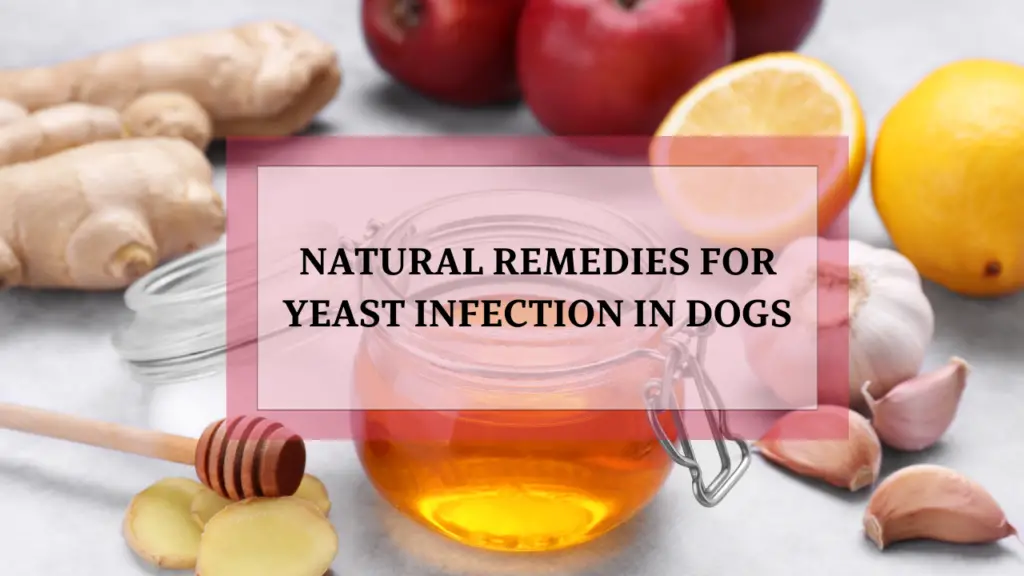Is your dog constantly scratching, licking, or smelling… well, a little funky?
You might be dealing with a yeast infection—and you’re not alone.
Yeast infections in dogs are surprisingly common. They’re itchy, uncomfortable, and if left untreated, they can get worse fast. Most often, they show up in your pup’s ears, paws, skin folds, or belly. And while medications from the vet can help, many pet parents are turning to natural remedies to relieve symptoms and stop the problem at its source.
If your dog also struggles with allergies or skin problems, you’ll want to pay extra attention—these issues often go hand in hand with yeast overgrowth. Supporting your pup with the right diet, like homemade dog food for skin allergies, can make a big difference.
In this post, we’ll cover 5 natural remedies for yeast infection in dogs that are safe, affordable, and easy to try at home. We’ll also talk about what yeast infections are, how to spot them, and when it’s time to call the vet.
Let’s help your dog feel better—naturally.
What Is a Yeast Infection in Dogs?
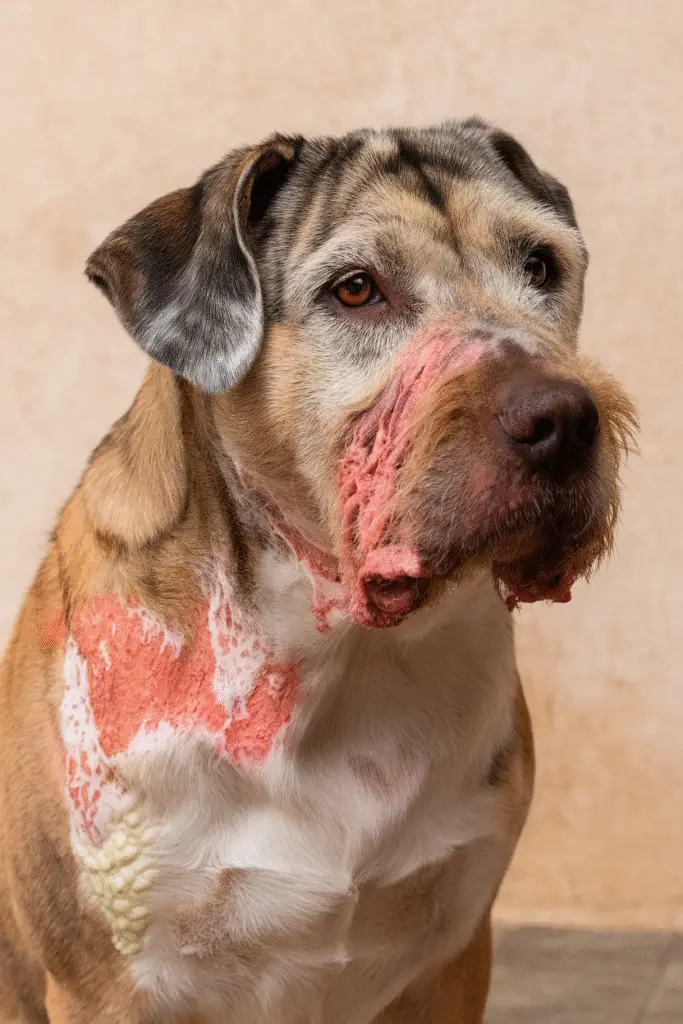
A yeast infection in dogs happens when there’s an overgrowth of yeast—specifically a fungus called Malassezia—on your dog’s skin. This type of yeast is normally present in small amounts, but when the balance gets thrown off, it can multiply fast and cause real discomfort. For itchy pups, a diet tailored to their needs like homemade dog food for allergies can make a difference.
What Causes Yeast Infections in Dogs?
The main culprit? Malassezia yeast getting out of control.
But what throws off the balance in the first place? Several things can set off a yeast flare-up:
- Allergies (to food, pollen, fleas—you name it)
- Moisture trapped in ears or between paw pads — keeping dog paw wipes handy helps prevent buildup
- Poor diet, especially high-carb kibble — switching to grain free dry dog food may reduce yeast triggers
- Overuse of antibiotics, which kill off good bacteria too
If you want to dig deeper into how food plays a role, see our guide on best homemade dog food recipes for a healthier pup.
Where Do Yeast Infections Usually Occur?
Yeast loves warm, damp places. That’s why you’ll often find infections in areas like:
- The ears (a top trouble spot for many breeds) — regular use of a dog ear cleaning solution can help
- Between the paws, especially if your dog licks them a lot
- Inside skin folds (think bulldogs or pugs) — a gentle dog skin fold cleaner works well
- Around the groin or belly
These spots are cozy little hideouts for yeast, especially if your pup is already dealing with allergies or irritation. Adding soothing care like remedies for itchy dog skin often brings relief.
Is It Contagious?
Here’s the good news: Yeast infections aren’t contagious. You can cuddle your pup without worrying about catching anything.
That said, if your dog is dealing with frequent or severe infections, it could point to an underlying issue—like allergies, immune imbalance, or poor gut health. Supporting digestion with homemade dog food for gastrointestinal health may help restore balance. Daily care tools such as dog probiotic chews also support the gut-skin connection.
Learn more in our guide: Understanding Yeast Infection in Dogs.
Why Choose Natural Remedies for Yeast Infections in Dogs?
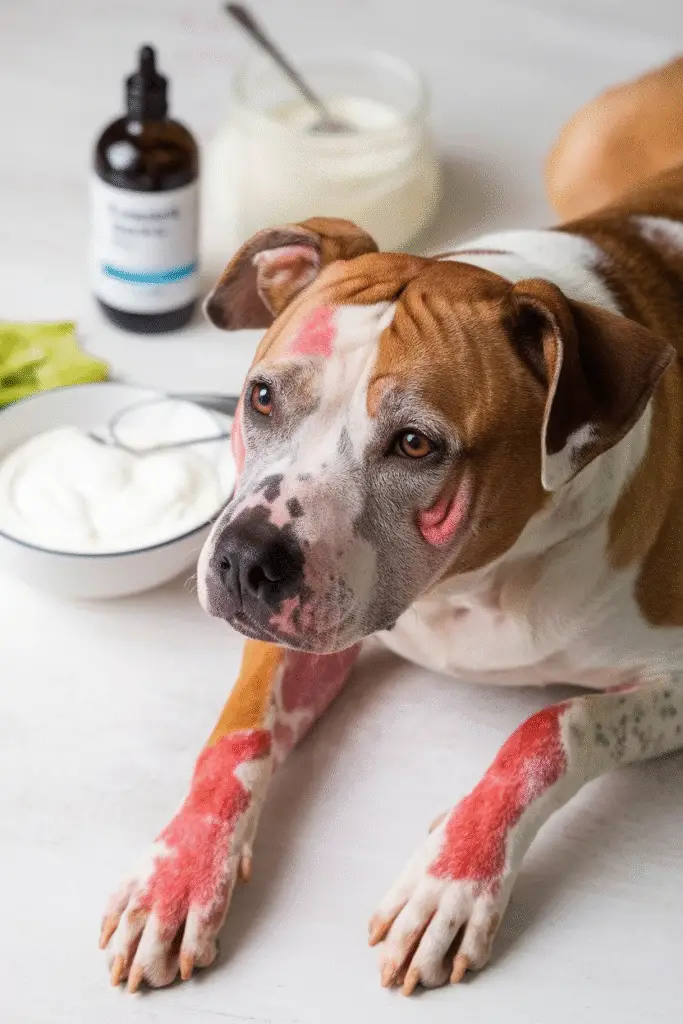
When your dog’s itching like crazy or smells like they rolled in a bag of corn chips, it’s tempting to reach straight for prescription meds. And sometimes, that’s exactly what’s needed. But in many cases—especially mild to moderate ones—natural remedies can do the trick just as well, with fewer side effects.
Natural vs. Prescription: The Pros and Cons
| Option | Pros | Cons |
|---|---|---|
| Natural Remedies | Gentle on the body, fewer side effects, affordable, easy to apply at home | May take longer to see results, not always strong enough for severe infections |
| Prescription Medications | Fast-acting, effective for serious or recurring cases | Can cause side effects, pricey, may weaken immune system if used long-term |
Natural treatments aren’t meant to replace your vet’s advice—but they can be a great first line of defense or an add-on to help prevent future flare-ups. For ongoing itchy skin relief, you might explore dog skin allergies home remedies as part of a natural plan. A gentle hypoallergenic dog shampoo is also useful for regular care.
When Do Natural Remedies Work Best?
- Early stages of a yeast infection
- Mild or localized cases (like just the paws or ears)
- As part of ongoing maintenance, especially if your dog is prone to recurring infections
- In combination with diet changes, such as feeding lower-carb, yeast-fighting foods
- To help soothe symptoms from related conditions like itchy or dry skin
These remedies are most effective when you catch the problem early. If your dog is already in discomfort, it’s worth trying—but keep an eye on symptoms and don’t hesitate to ask your vet for guidance. Many owners also support healing with a better diet, like homemade dog food for dry skin, along with supplements such as dog probiotics to restore gut balance.
Vet-Approved and Safe for Dogs
Natural doesn’t always mean safe. Some ingredients that are fine for humans can irritate or harm dogs. That’s why it’s essential to stick to vet-approved remedies and use correct dosages, especially with oils, herbs, or DIY mixes. For safe at-home help, 11 dog remedies for everyday ailments provides helpful guidance. Keeping a bottle of dog ear cleaning solution at home also helps manage yeast-prone areas.
Pro tip: Always do a small patch test before applying anything new to a larger area of your dog’s body.
Talk to Your Vet First
Even if you’re going the natural route, your vet should be part of the plan. They can help you:
- Confirm it’s actually a yeast infection (not mites or bacteria)
- Recommend safe, effective natural treatments
- Monitor your dog’s progress to make sure things don’t get worse
Natural remedies can be amazing, but they’re not a one-size-fits-all fix. When used the right way—and with your vet’s guidance—they can help your dog heal faster and feel better naturally. For more holistic support, you may also explore homemade dog food recipes for healthier pups.
5 Natural Remedies for Yeast Infection in Dogs
If you’re looking for gentle, effective ways to help your dog heal, natural remedies can be a game-changer. These treatments support your dog’s body without harsh chemicals—and they’re often things you already have at home.
Let’s dive into five proven, vet-friendly options to tackle yeast infections in dogs.
1. Apple Cider Vinegar Spray
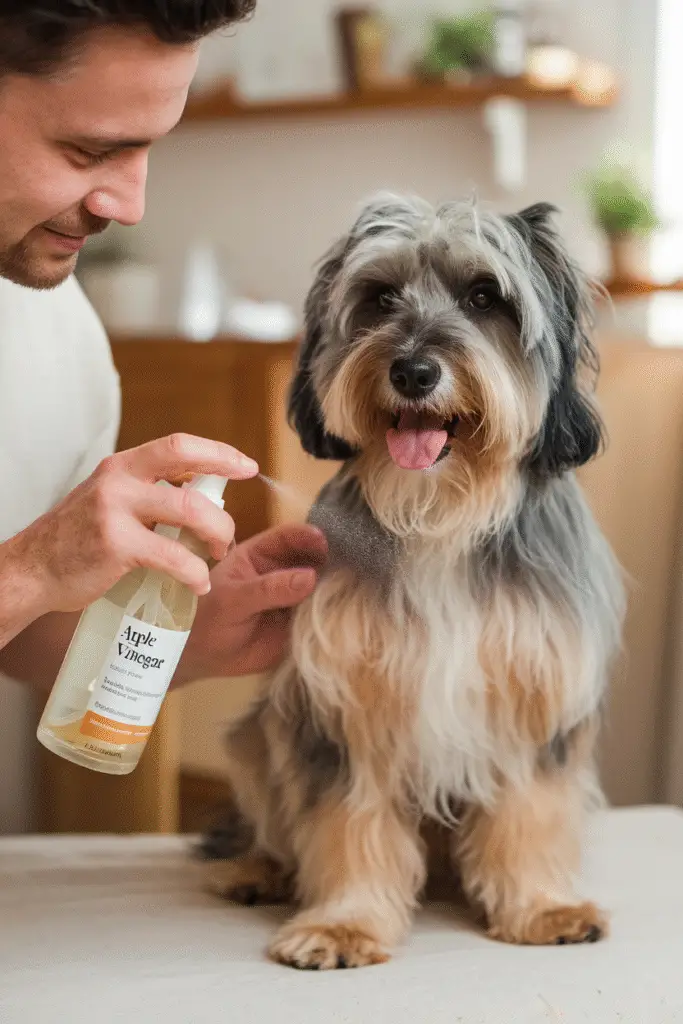
Why it works:
Apple cider vinegar (ACV) is naturally antifungal. It helps restore your dog’s skin pH and kills yeast on contact—especially when used consistently. For dogs prone to itchy skin or recurring infections, combining ACV with Natural Remedies for Yeast Infection in Dogs can make results even more effective.
How to Use It:
- Mix equal parts water and raw, unfiltered apple cider vinegar (50/50).
- Pour into a spray bottle.
- Spray directly on affected areas like paws, armpits, and belly—but never on open wounds or raw skin. It’ll sting like crazy.
💡 If your pup also struggles with allergies, you may want to check out these Dog Skin Allergies Home Remedies for added relief.
Can It Be Used on Paws or Ears?
- Paws: Yes—especially if your dog licks or chews at their feet.
- Ears: Be careful. Never pour ACV directly in the ears. Instead, use a damp cotton ball to gently wipe the outer ear.
How Often to Apply:
- 1–2 times daily until symptoms improve.
- Continue a few times per week for maintenance.
👉 For long-term results, pair ACV treatments with a yeast-fighting diet, like the ones shared in Homemade Dog Food for Dogs with Yeast.
Learn more about yeast hotspots like paws and ears in our post on Understanding Yeast Infection in Dogs.
2. Coconut Oil
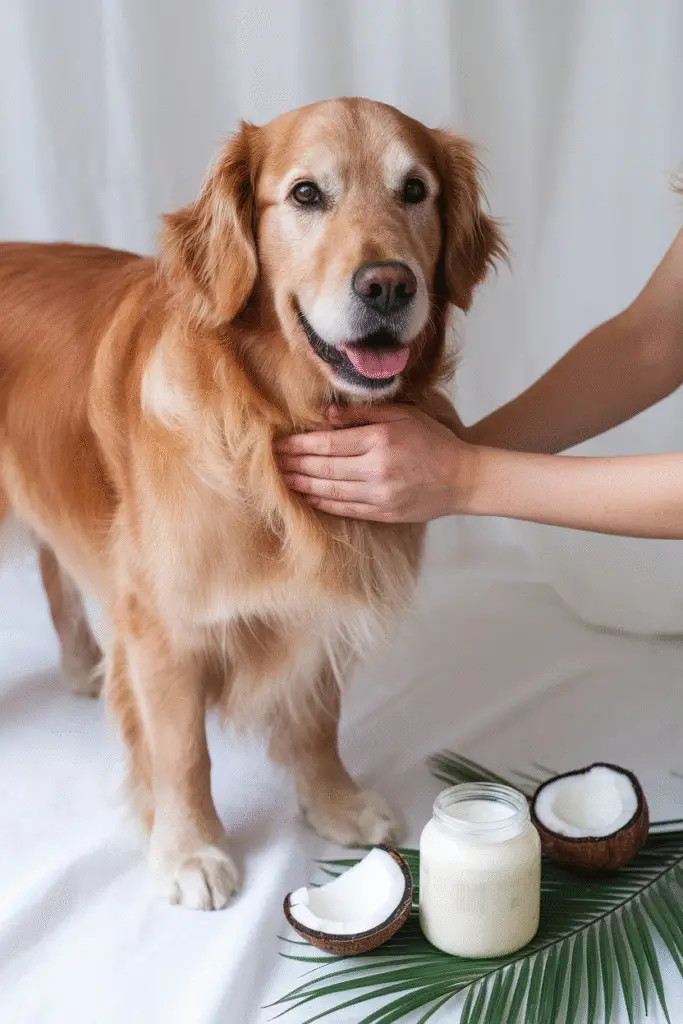
Why it works: Coconut oil is loaded with caprylic acid, a natural antifungal that kills yeast. It’s also moisturizing and safe if your dog licks it off (which they probably will).
How to Apply
- Rub a small amount directly onto irritated or flaky skin.
- For internal benefits, add ½ to 1 teaspoon per 10 pounds of body weight to their food. Start slowly. A scoopable organic coconut oil for dogs can make this easy.
Is It Safe for All Breeds?
Yes! Coconut oil is safe for most dogs—but start with a small amount, especially for breeds prone to pancreatitis or sensitive stomachs. Pairing it with a balanced diet, like those in 12 trusted ways to soothe your dog’s upset stomach, can support digestion while improving skin.
How Long to See Results
Some dogs show relief in a few days, while others may take 1–2 weeks of consistent use. To keep skin soft and yeast under control, many owners rotate coconut oil with a gentle dog moisturizing balm.
👉 For more gentle ways to support your pup’s skin, check out our guide on 14 effective remedies for your dog’s itchy skin. You might also find helpful tips in 11 dog remedies for everyday ailments at home.
3. Probiotics for Dogs
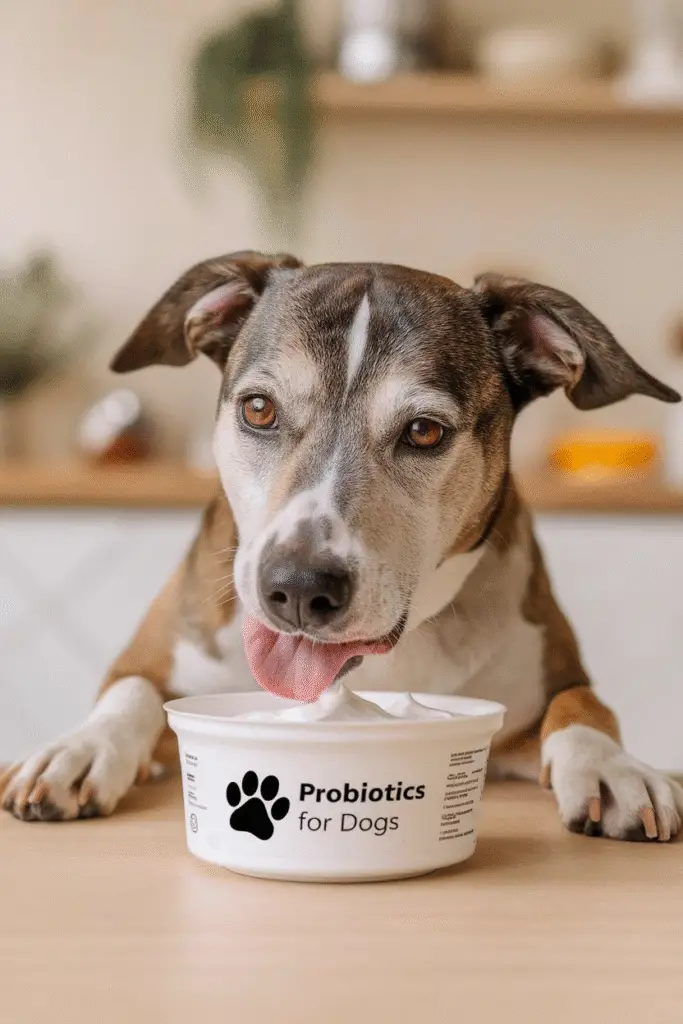
Why Gut Health Matters
Yeast overgrowth often starts in the gut. If your dog’s microbiome is out of balance—thanks to antibiotics, stress, or poor diet—yeast can spread fast. A balanced diet, like the recipes we share in homemade dog food for gut health, can play a big role in prevention. For ongoing digestive support, some owners also use dog probiotic chews as part of their daily routine.
Natural Sources of Probiotics
- Plain, unsweetened yogurt
- Kefir (fermented milk)
- Fermented veggies in tiny amounts (like sauerkraut—no garlic or onions!)
We also include probiotic-friendly meal ideas in our homemade dog food for gastrointestinal issues guide. Adding a spoonful of goat milk for dogs to meals is another easy way to boost probiotics naturally.
Store-Bought Supplements
Choose a dog-specific formula with multiple strains of good bacteria, like Lactobacillus and Bifidobacterium. Look for products labeled “live and active cultures.” Pairing supplements with omega-rich meals, such as those in 5 Omega-3 packed homemade dog food for skin health, helps support both gut and skin health. If you’re not sure which supplement to choose, a multi-strain probiotic powder for dogs is a versatile option.
How Long to Use Them
For dogs prone to yeast, long-term use is safe and recommended. Start daily for 4–6 weeks, then adjust based on your dog’s needs. Maintaining a consistent routine with both diet and probiotics is key for lasting results.
4. Oatmeal and Herbal Baths
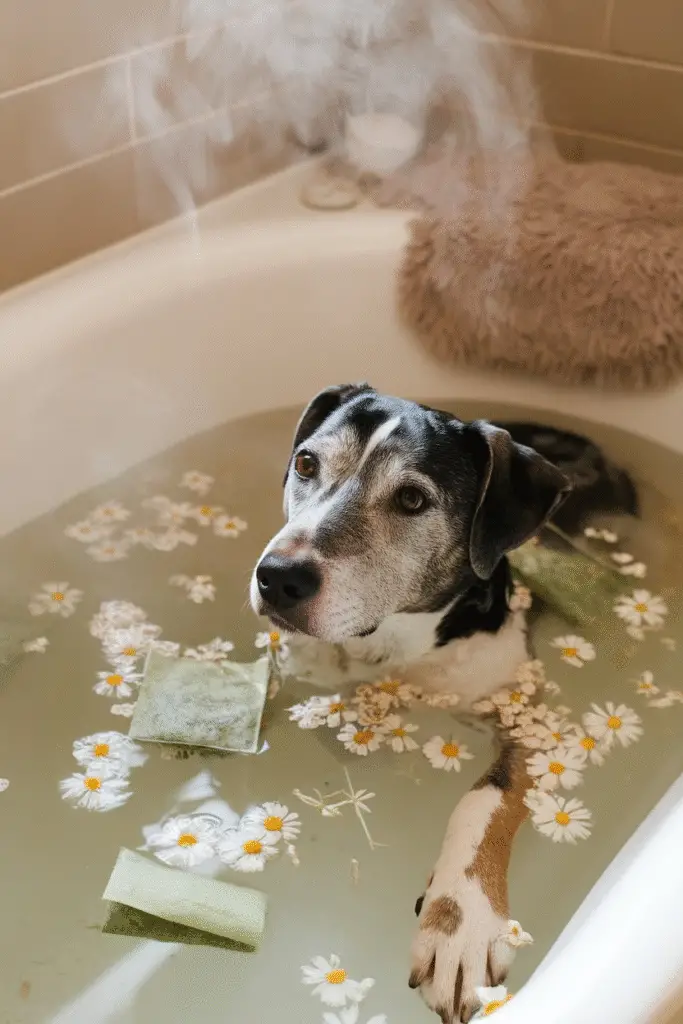
Why It Works
Oatmeal is soothing and helps relieve itching and inflammation. Add calming herbs like chamomile or green tea, and you’ve got a healing spa day for your pup. For more tips on easing irritation, see our guide on dog skin allergies home remedies. A ready-made colloidal oatmeal dog shampoo can also be a gentle option between baths.
Simple DIY Oatmeal Bath Recipe
- Grind 1 cup of plain oatmeal into a fine powder.
- Brew 2–3 chamomile tea bags or green tea bags in hot water.
- Fill the tub with warm (not hot) water.
- Stir in the oatmeal and brewed tea.
- Let your dog soak for 10–15 minutes.
- Pat dry—don’t rinse it off!
If your pup struggles with skin irritation often, pairing baths with a nourishing diet like our homemade dog food for dry skin can help heal from the inside out too. Adding a touch of dog-safe coconut oil after drying can lock in moisture.
How Often to Bathe
- 1–2 times per week during a flare-up
- Reduce to every 2–3 weeks once the skin improves
Want more natural soothing ideas? Check out 14 effective remedies for your dog’s itchy skin. Keeping a jar of dog paw balm handy can also help protect sensitive spots between baths.
5. Diet Changes and Anti-Yeast Foods
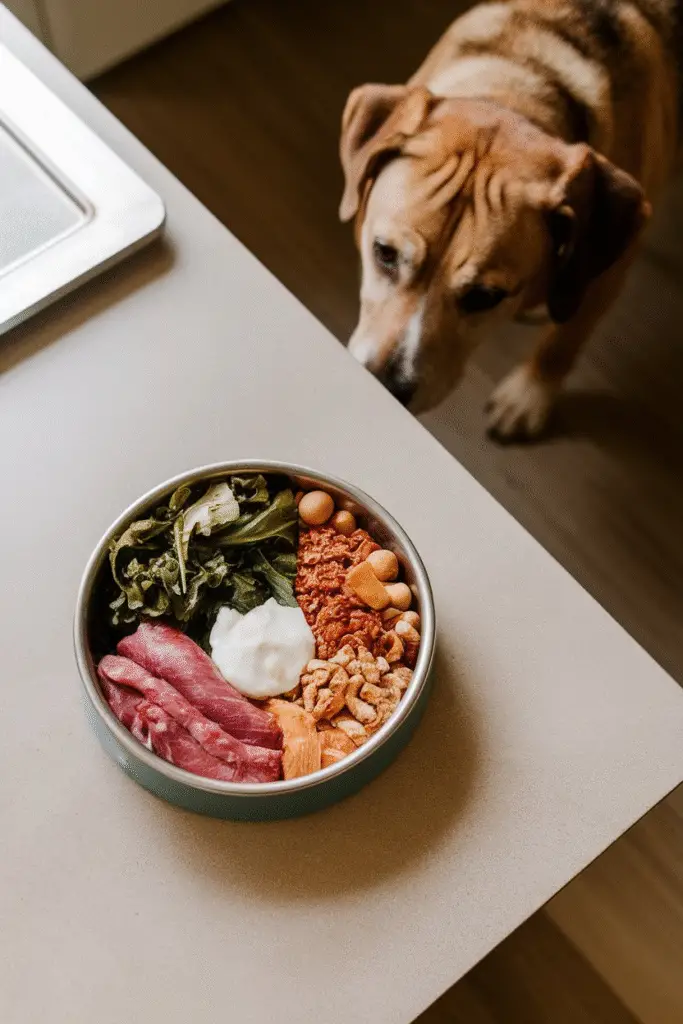
Why It Matters
Yeast feeds on sugar and starch—which means a high-carb or low-quality diet can make infections worse. Cleaning up your dog’s meals can stop yeast at the source. Dogs that already struggle with digestion often do better on softer meals, much like the ones in homemade dog food for dogs with no teeth. If you’re looking for an easy shortcut, some owners also rotate in fresh dog food toppers to keep meals gentle on the stomach.
Ingredients to Avoid
- Corn, wheat, and soy
- Starchy veggies like potatoes or peas
- Processed treats with fillers and sugar
Some of these same foods are also known triggers in dogs prone to stomach upset, which is why gentle adjustments like those found in ways to soothe an upset stomach can make a difference. Replacing carb-heavy snacks with healthier grain-free dog treats helps avoid hidden yeast triggers.
Best Natural Anti-Yeast Foods
A simple diet built around lean proteins such as chicken or turkey, along with lightly cooked greens, can help starve out yeast. Healthy fats like organic coconut oil bring antifungal benefits, while small additions of probiotic supplements support the gut.
Some pet parents also find success with balanced recipes like homemade dog food for chicken allergies, which naturally avoids many yeast-promoting foods. Pairing meals with a dog probiotic supplement can further improve gut balance.
Sample Anti-Yeast Meal
Try mixing ground turkey with cooked spinach and a spoonful of plain yogurt for an easy, yeast-fighting bowl. If you’d rather not cook, a grain-free dog food for sensitive skin can be a reliable option that avoids common triggers while still supporting healthy skin.
Bonus Tips to Prevent Future Yeast Infections

Tired of treating yeast infections over and over again? Prevention is the secret sauce.
Dry your dog completely after baths or swimming
Yeast thrives in warm, damp spots. Toweling off thoroughly—ears, paws, belly folds, and armpits—goes a long way. Some owners also keep a dog blow dryer handy for a gentle, cool finish. If your pup’s skin is extra sensitive, a nourishing diet such as homemade dog food for skin allergies can strengthen defenses from within.
Clean ears and paws regularly
A weekly routine helps stop yeast before it builds up. A gentle dog ear cleaning solution paired with soft paw wipes works well, especially in humid climates. For dogs prone to chronic irritation, dog skin allergies natural remedies may provide additional comfort.
Use vet-approved ear cleaners or paw wipes
Avoid alcohol-heavy products—they dry out and irritate. Dog-specific solutions are designed to keep skin flora balanced without harsh side effects. Some pet parents also find success combining these with the guidance in 11 dog remedies for everyday ailments at home.
Don’t over-bathe—preserve natural skin oils
Too many baths can strip the skin of its protective layer, allowing yeast to flare up. Stick to once every 2–3 weeks unless advised otherwise. A gentle hypoallergenic dog shampoo can help maintain balance without drying out the skin.
Keep food and water bowls clean
Bacteria and yeast love dirty bowls. Wash dishes daily with hot, soapy water to avoid infections. If your pup is sensitive to gut imbalances, you might also like our guide on homemade dog food for gastrointestinal health. And for added peace of mind, switching to a stainless steel dog food and water bowl set makes cleaning easier.
When to See a Vet for Your Dog’s Yeast Infection
Natural remedies are super helpful—but they’re not a one-size-fits-all fix. Sometimes, it’s time to call in the pros.
If symptoms get worse
Natural treatments should start easing discomfort within a week or so. If your dog’s itching, redness, or odor is getting worse instead of better, it’s time for a check-up. Dogs with persistent irritation often benefit from gentle routines like those in dog skin allergies home remedies. Keeping a skin-soothing spray for dogs on hand may also bring relief while you wait for your vet visit.
Signs of secondary infection
Open sores, pus, bleeding, or scabs may point to bacterial infections that require medical treatment. To help prevent flare-ups, some owners turn to balanced meals like homemade dog food for ear infections. For immediate comfort, gentle antimicrobial dog wipes can keep irritated areas clean between treatments.
Recurring yeast infections
If infections keep coming back, there might be deeper issues—such as allergies, immune imbalance, or an underlying condition. Supporting immunity with better diet choices, like best healthy homemade dog food recipes, is one long-term step. Some pet owners also explore dog allergy supplements to help manage triggers.
Combining natural and prescription treatments
Sometimes the best approach is a mix of both. A vet can guide you on safely pairing antifungal meds with natural options like coconut oil or probiotics. Our guide on 12 effective remedies for dog diarrhea also shows how everyday home care can complement veterinary treatment. Alongside professional care, simple tools such as a pill pocket dog treat can make giving medication stress-free.
FAQs About Natural Remedies for Yeast Infections in Dogs
Can I use human anti-fungal cream on my dog?
Not recommended—at least not without your vet’s OK. Some human creams contain ingredients toxic to dogs if licked or absorbed. Safer options include pet-formulated antifungal sprays or dog-safe antifungal shampoos. From the nutrition side, a gentle diet like homemade dog food for sensitive stomachs can help reduce yeast flare-ups.
How long do natural remedies take to work?
It depends on severity and consistency. Mild cases may improve in 3–5 days, while tougher ones might take 2–3 weeks. If there’s no improvement after 7–10 days, consult your vet. Many owners combine remedies with balanced meals such as 15 vet-approved homemade dog food recipes for long-term support.
Can I combine more than one natural remedy?
Absolutely! A multi-approach plan (like probiotics + ACV spray + diet changes) often works best. Just don’t overload—stick to a few and monitor your dog closely. Adding a dog probiotic powder to food is one easy way to support gut balance while using topical care.
Are essential oils safe for yeast infections in dogs?
Use with caution. Many oils—like tea tree in high doses—are toxic. Always dilute heavily and check with your vet. Some owners avoid oils altogether and instead focus on nourishing meals such as best homemade dog food recipes for a healthier pup. For gentle topical care, dog-safe calming sprays are often a safer choice.
Is a yeast infection in dogs dangerous?
Not usually—but it’s very uncomfortable. If left untreated, it can lead to skin damage, secondary infections, and chronic flare-ups. The good news: with proper care, yeast infections are highly treatable. Supporting skin with diets like homemade dog food for dry skin and maintaining hygiene with dog ear cleaning wipes helps keep problems under control.

Hi, I’m Ali Tarek, the founder of Animalsman. I’ve always been passionate about pets, especially dogs and cats, and I created this website to share practical tips, easy recipes, and helpful care advice for fellow pet lovers. My goal is to make pet care simple, enjoyable, and accessible for everyone. When I’m not writing or curating content, you’ll usually find me spending time with my furry friends or learning new ways to keep them happy and healthy.

